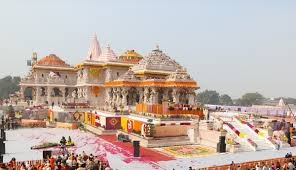Introduction
The Ram Janmabhoomi Temple in Ayodhya, Uttar Pradesh, is one of the most sacred and revered sites for Hindus worldwide. Believed to be the birthplace of Lord Rama, this temple holds immense religious, cultural, and historical significance. Over the centuries, it has been a symbol of faith, devotion, and perseverance.
As the Ram Mandir takes shape, millions of devotees eagerly anticipate witnessing the grand structure that will stand as a beacon of spirituality. The temple’s construction is not just an architectural marvel but also a testament to the unwavering faith of devotees who have long awaited this moment.
Whether you are a pilgrim seeking blessings, a history enthusiast, or a traveler exploring India’s spiritual heritage, the Ram Janmabhoomi Temple is a must-visit destination that offers an enriching experience.
Historical Significance of Ram Janmabhoomi
The history of Ram Janmabhoomi dates back thousands of years. According to Hindu tradition, Ayodhya is the birthplace of Lord Rama, the seventh incarnation of Lord Vishnu and the protagonist of the epic Ramayana.
Ancient texts, including the Valmiki Ramayana and Skanda Purana, describe Ayodhya as a divine city blessed with spiritual energy. Over centuries, the site remained a place of worship, with numerous temples built to honor Lord Rama. However, historical conflicts led to the destruction and reconstruction of these temples multiple times.
In modern history, the site became a focal point of religious and legal disputes. After a long legal battle, the Supreme Court of India gave its verdict in 2019, paving the way for the construction of the Ram Mandir. Since then, the temple has been under construction, with its grand inauguration scheduled for 2024.
Architectural Marvel of Ram Mandir
The Ram Janmabhoomi Temple is being built in the traditional Nagara style of temple architecture, following ancient Hindu principles. Designed with intricate carvings, majestic pillars, and divine sculptures, the temple reflects the grandeur of India’s spiritual heritage.
Key Architectural Features
- Grand Structure: The temple will stand 161 feet tall with three floors, symbolizing spiritual ascension.
- Magnificent Sanctum: The inner sanctum will house a 5-year-old idol of Lord Rama, depicting him as a child.
- Intricate Carvings: The temple walls and pillars will showcase carvings of Hindu deities and mythological stories.
- Massive Courtyard: A spacious courtyard will allow thousands of devotees to offer prayers.
- Surrounding Shrines: The temple complex will include smaller shrines dedicated to Lord Hanuman, Goddess Sita, Lakshmana, and other revered deities.
The temple’s construction follows the Vastu Shastra and Shilpa Shastra traditions, ensuring spiritual and architectural perfection.
Spiritual Importance of Ram Janmabhoomi
For Hindus, Ram Janmabhoomi is not just a temple—it is a place where faith, devotion, and divine energy converge. The very land where Lord Rama was born is believed to radiate spiritual power, blessing devotees who visit with peace and prosperity.
Why Do Devotees Visit Ram Janmabhoomi?
- To Seek Lord Rama’s Blessings: Praying at the birthplace of Lord Rama is believed to bring peace, happiness, and fulfillment of desires.
- To Experience Divine Energy: The sacred vibrations of the temple create an atmosphere of devotion and positivity.
- To Witness a Historic Moment: The temple represents the culmination of centuries of faith, making it a landmark of spiritual history.
During festivals, the temple becomes even more vibrant, with grand celebrations attracting devotees from across the world.
Festivals Celebrated at Ram Janmabhoomi
The Ram Janmabhoomi Temple comes alive during Hindu festivals, with thousands of devotees participating in rituals and celebrations.
Ram Navami
The most significant festival celebrated here is Ram Navami, marking the birth of Lord Rama. Devotees gather in large numbers, singing bhajans, offering prayers, and seeking divine blessings. The temple is beautifully decorated, and the atmosphere is filled with devotion.
Diwali
Diwali, the festival of lights, holds special importance in Ayodhya. It is believed that Lord Rama returned to Ayodhya after his 14-year exile, and the city was illuminated with diyas. Even today, millions of diyas light up Ayodhya during this festival, creating a breathtaking spectacle.
Dussehra
Dussehra, symbolizing the victory of good over evil, is celebrated with great enthusiasm. The burning of Ravana’s effigy reminds devotees of Lord Rama’s triumph and reinforces the teachings of righteousness.
Other Celebrations
Festivals like Makar Sankranti, Holi, and Kartik Purnima are also celebrated with great devotion at the temple, drawing devotees from across the country.
Rituals and Prayers at Ram Janmabhoomi
Devotees visiting the Ram Janmabhoomi Temple can participate in several rituals and offerings to seek blessings from Lord Rama.
- Morning and Evening Aarti: The temple conducts daily aartis where devotees sing hymns and offer prayers.
- Special Pujas: Devotees can perform special pujas for health, prosperity, and spiritual growth.
- Offering Prasad: Many devotees offer sweets, fruits, and flowers to Lord Rama, which is later distributed as prasad.
- Reciting Ramayana: Reading or listening to the Ramayana inside the temple premises enhances spiritual connection.
The divine atmosphere and melodious chants of “Jai Shri Ram” create an unforgettable spiritual experience.
Best Time to Visit Ram Janmabhoomi Temple
The best time to visit the Ram Janmabhoomi Temple is during the winter months, from October to March, when the weather is pleasant.
For those who want to witness grand celebrations, visiting during Ram Navami or Diwali is ideal. However, these festivals also attract large crowds, so early morning visits are recommended.
How to Reach Ram Janmabhoomi Temple
Ayodhya is well-connected by road, rail, and air, making it easily accessible from different parts of India.
- By Air: The nearest airport is Maharishi Valmiki International Airport, Ayodhya, which is well-connected to major cities.
- By Train: Ayodhya Railway Station and Faizabad Railway Station serve as major railheads, with regular trains from Delhi, Mumbai, Kolkata, and other cities.
- By Road: Regular bus and taxi services operate from Lucknow, Varanasi, and Prayagraj to Ayodhya.
Once in Ayodhya, auto-rickshaws and cycle-rickshaws provide easy access to the temple.
Tips for Visitors
- Respect Temple Traditions: Maintain decorum and follow temple rules.
- Dress Modestly: Wear traditional or modest clothing as a sign of respect.
- Visit Early in the Morning: To avoid crowds and experience peace, arrive early.
- Avoid Carrying Large Bags: Security checks are in place, so avoid carrying large bags.
- Explore Other Temples: Ayodhya is home to several other temples, such as Hanuman Garhi and Kanak Bhawan, worth visiting.
Conclusion
The Ram Janmabhoomi Temple is more than just a place of worship—it is a symbol of unwavering faith, unity, and devotion. As the temple nears completion, it stands as a testament to the deep spiritual connection Hindus have with Lord Rama.
Whether you seek divine blessings, peace, or a glimpse into India’s rich heritage, visiting Ram Janmabhoomi Temple promises an unforgettable spiritual experience. Plan your pilgrimage and immerse yourself in the divine aura of Ayodhya!





